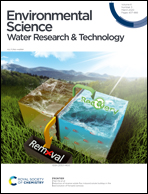Clustering micropollutants based on initial biotransformations for improved prediction of micropollutant removal during conventional activated sludge treatment†
Abstract
The lack of fundamental insights on the fate of micropollutants during conventional activated sludge treatment in wastewater treatment plants (WWTPs) presents one of the biggest challenges in optimizing their removal. To address this challenge, we designed a study to identify the drivers of micropollutant removal in WWTPs. We calculated the removal efficiency of micropollutants across the activated sludge process of full-scale wastewater treatment plants from literature-reported data. Our final dataset consisted of 529 independent observations for 84 micropollutants along with a set of associated activated sludge process parameters. We used the Eawag pathway prediction system to predict initial biotransformations for each of the 84 micropollutants and hierarchical clustering to group chemicals based on similarities in their predicted initial sets of biotransformations. We then applied stability selection to generate well-performing models that can be interpreted to uncover the key factors contributing to the range of removal efficiencies calculated for each cluster of micropollutants. The key factors considered in stability selection included six physicochemical properties of the micropollutants and six activated sludge process parameters. The sludge–water partitioning coefficient, molecular weight, solids retention time, influent micropollutant concentration, and dissolved oxygen levels were consistently identified as key factors of micropollutant removal for clusters of micropollutants that undergo certain types of initial biotransformations. Our findings highlight the importance of considering initial biotransformations when evaluating micropollutant removal and identify important process parameters that determine the fate of micropollutants during activated sludge treatment.



 Please wait while we load your content...
Please wait while we load your content...